Lung cancer diagnostic study of choice
|
Lung cancer Microchapters |
|
Diagnosis |
|---|
|
Treatment |
|
Case Studies |
|
Lung cancer diagnostic study of choice On the Web |
|
American Roentgen Ray Society Images of Lung cancer diagnostic study of choice |
|
Risk calculators and risk factors for Lung cancer diagnostic study of choice |
Editor-In-Chief: C. Michael Gibson, M.S., M.D. [1]; Associate Editor(s)-in-Chief: Dildar Hussain, MBBS [2]Kim-Son H. Nguyen M.D., Cafer Zorkun, M.D., Ph.D. [3]. Rim Halaby, M.D. [4], Michael Maddaleni, B.S.
Overview
Chest CT scan is the modality of choice in the diagnosis of lung cancer. Findings on CT scan suggestive of lung cancer include a solitary pulmonary nodule, centrally located masses, mediastinal invasion CT scans help stage the lung cancer. A CT scan of the abdomen and brain can help visualize the common sights of metastases such as adrenal glands, liver, and brain. CT scans diagnose lung cancer by providing anatomical detail to locate the tumor, demonstrating proximity to the nearby structures, and deciphering whether lymph nodes are enlarged in the mediastinum.
Diagnostic Study of Choice
Study of Choice
Chest CT scan is the modality of choice in the diagnosis of lung cancer. Findings on CT scan suggestive of lung cancer include:[1]
- Solitary pulmonary nodule
- Centrally located masses
- Mediastinal invasion
- Peripherally situated lesions invading the chest wall
- A ground-glass opacity
- Consolidation
- Mixed density or pure ground glass nodules
- Mixed density or pure ground glass consolidation
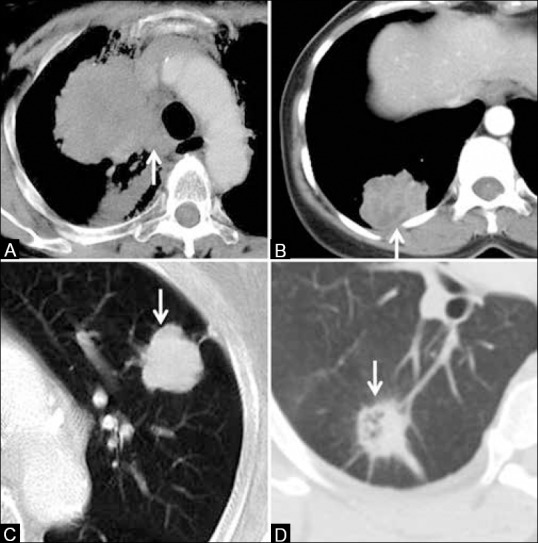 |
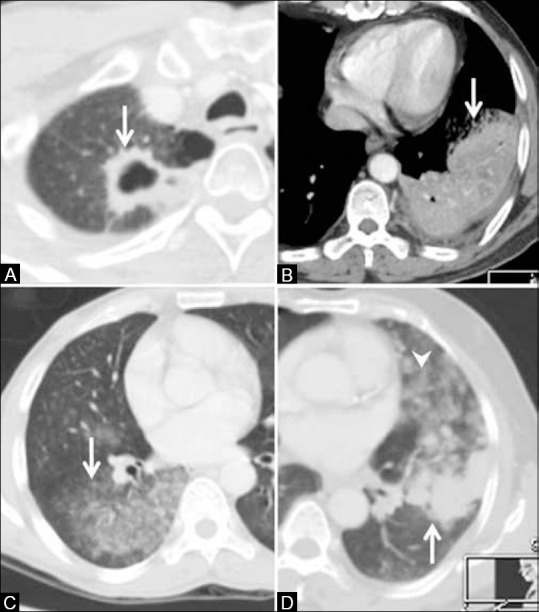 |
 |
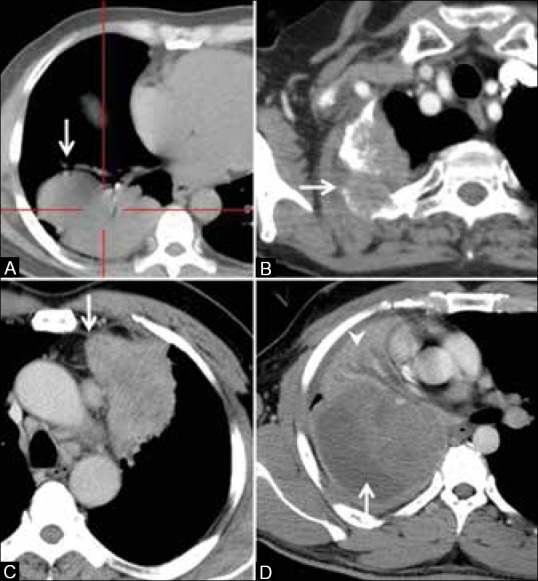 |
 |
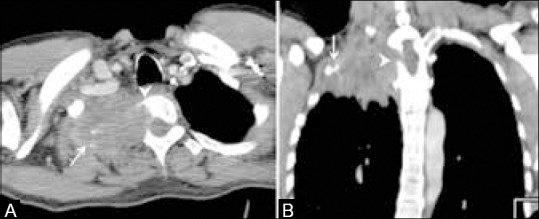 |
Spiral CT Perfusion Imaging
- Spiral CT perfusion study can be used as a diagnostic method for peripheral pulmonary nodules.
- Spiral CT perfusion study provides non-invasive method for the quantitative assessment of blood flow patterns of peripheral pulmonary nodules.
- Spiral CT perfusion imaging is analyzed and evaluated for:[2]
- TDC (time density curve)
- Perfusion parametric maps
- The respective perfusion parameters
- Immunohistochemical findings of microvessel density (MVD) measurement
- VEGF expression
 |
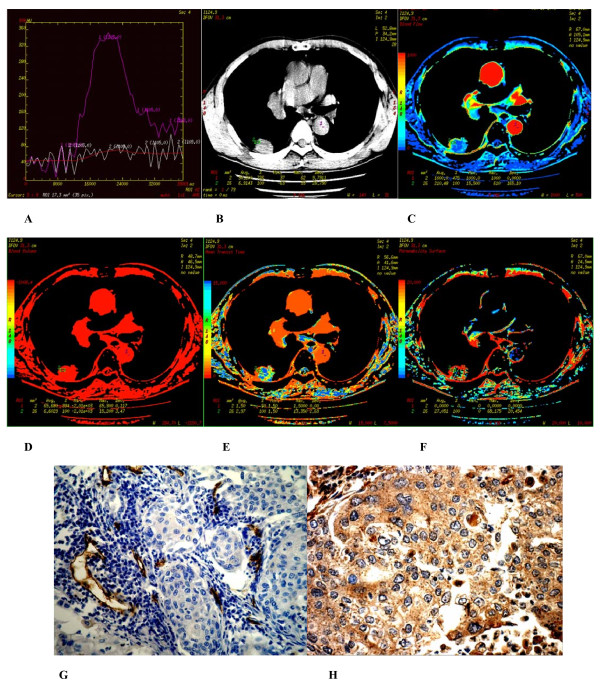 |
CT Findings of Metastatic disease
- CT scans help stage the lung cancer. A CT scan of the abdomen and brain can help visualize the common sights of metastases such as adrenal glands, liver, and brain.
- The benefits of CT scan in lung cancer patients are the following:[3]
- Provides anatomical detail to locate the tumor
- Demonstrates proximity to nearby structures
- Deciphers whether lymph nodes are enlarged in the mediastinum
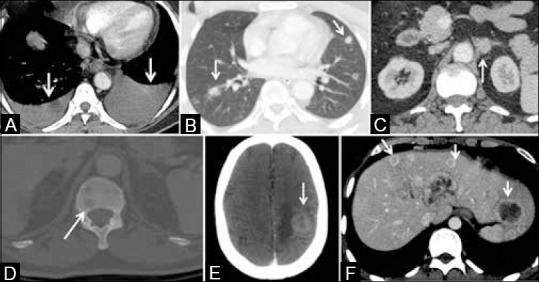 |
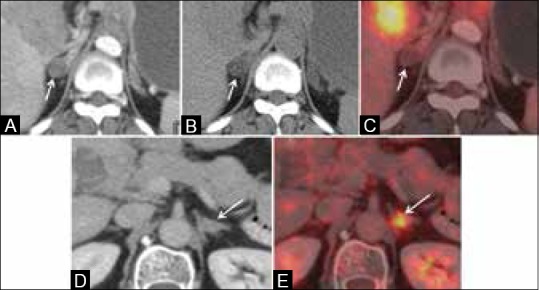 |
 |
- Unfortunately, research has shown that there are a number of false positives associated with CT scanning because CT scan alone cannot determine malignancy.
- A positive result for a tumor using CT scan is typically followed up with a biopsy for confirmation.
Staging
The following is 2017 TNM classification of lung cancer.[4][5][6]
T: Primary Tumor
| T | Description |
| TX |
|
|---|---|
| T0 |
|
| Tis | |
| T1 |
|
| T2 |
|
| T3 |
AND
|
| T4 |
|
N: Regional Lymph Nodes
| T | Description |
| NX |
|
|---|---|
| N0 |
|
| N1 |
|
| N2 |
|
| N3 |
|
M: Distant Metastasis
| T | Description |
| MX |
|
|---|---|
| M0 |
|
| M1 |
|
Classification of Lung Cancer by Staging
| Stage | T | N | M |
| Occult carcinoma | TX | N0 | M0 |
| Stage 0 | Tis | N0 | M0 |
| Stage IA1 | T1(mi)/T1a | N0 | M0 |
| Stage IA2 | T1b | N0 | M0 |
| Stage IA3 | T1c | N0 | M0 |
| Stage IB | T2a | N0 | M0 |
| Stage IIA | T2b | N0 | M0 |
| Stage IIB | T1a | N1 | M0 |
| T1c | N1 | M0 | |
| T2a | N1 | M0 | |
| T2b | N1 | M0 | |
| T3 | N0 | M0 | |
| Stage IIIA | T1a | N2 | M0 |
| T1b | N2 | M0 | |
| T1c | N2 | M0 | |
| T2a | N2 | M0 | |
| T2b | N2 | M0 | |
| T1a | N2 | M0 | |
| T1b | N2 | M0 | |
| T1c | N2 | M0 | |
| T2a | N2 | M0 | |
| T2b | N2 | M0 | |
| T3 | N1 | M0 | |
| T4 | N0 | M0 | |
| T4 | N1 | M0 | |
| Stage IIIB | T1a | N3 | M0 |
| T1b | N3 | M0 | |
| T1c | N3 | M0 | |
| T2a | N3 | M0 | |
| T2b | N3 | M0 | |
| T1a | N3 | M0 | |
| T1b | N3 | M0 | |
| T1c | N3 | M0 | |
| T2a | N3 | M0 | |
| T2b | N3 | M0 | |
| T3 | N2 | M0 | |
| T4 | N2 | M0 | |
| Stage IIIC | T3 | N3 | M0 |
| T4 | N3 | M0 | |
| Stage IVA | Any T | Any N | M1a |
| Any T | Any N | M1b | |
| Stage IVB | Any T | Any N | M1c |
Procedures for Staging Lung Cancer
- There are currently multiple different procedures available to stage lung cancer.
Invasive
- EUS-NA (esophageal endoscopic ultrasound with needle aspiration)
- TBNA (transbronchial needle aspiration)
- EBUS-NA (endobronchial ultrasound with needle aspiration)
- TTNA (transthoracic needle aspiration)
- VATS staging (video assisted thoracic surgery) aka thoracoscopy
- Extended cervical mediastinoscopy
- Chamberlain procedure
Minimally Invasive
- EBUS-FNA (endobronchial ultrasound guided fine needle aspiration)
- EUS-FNA (esophageal endoscopic ultrasound guided fine needle aspiration)
References
- ↑ 1.0 1.1 1.2 1.3 1.4 1.5 1.6 1.7 1.8 1.9 Purandare, NilenduC; Rangarajan, Venkatesh (2015). "Imaging of lung cancer: Implications on staging and management". Indian Journal of Radiology and Imaging. 25 (2): 109. doi:10.4103/0971-3026.155831. ISSN 0971-3026.
- ↑ 2.0 2.1 2.2 Ma, Shu-Hua; Le, Hong-Bo; Jia, Bao-hui; Wang, Zhao-Xin; Xiao, Zhuang-Wei; Cheng, Xiao-Ling; Mei, Wei; Wu, Min; Hu, Zhi-Guo; Li, Yu-Guang (2008). "Peripheral pulmonary nodules: Relationship between multi-slice spiral CT perfusion imaging and tumor angiogenesis and VEGF expression". BMC Cancer. 8 (1). doi:10.1186/1471-2407-8-186. ISSN 1471-2407.
- ↑ Gerard A. Silvestri, Lynn T. Tanoue, Mitchell L. Margolis, John Barker, Frank Detterbeck.11/30/11.The Noninvasive Staging of Non Small-cell Lung Cancer. Chestpubs. http://chestjournal.chestpubs.org/content/123/1_suppl/147S.full/
- ↑ Mountain, CF (2003). A Handbook for Staging, Imaging, and Lymph Node Classification. Charles P Young Company. Retrieved 2007-09-01. Unknown parameter
|coauthors=ignored (help) - ↑ Collins, LG (Jan 2007). "Lung cancer: diagnosis and management". American Family Physician. American Academy of Family Physicians. 75 (1): 56–63. PMID 17225705. Retrieved 2007-08-10. Unknown parameter
|coauthors=ignored (help) - ↑ Harms, A.; Kriegsmann, M.; Fink, L.; Länger, F.; Warth, A. (2017). "Die neue TNM-Klassifikation für Lungentumoren". Der Pathologe. 38 (1): 11–20. doi:10.1007/s00292-017-0268-y. ISSN 0172-8113.